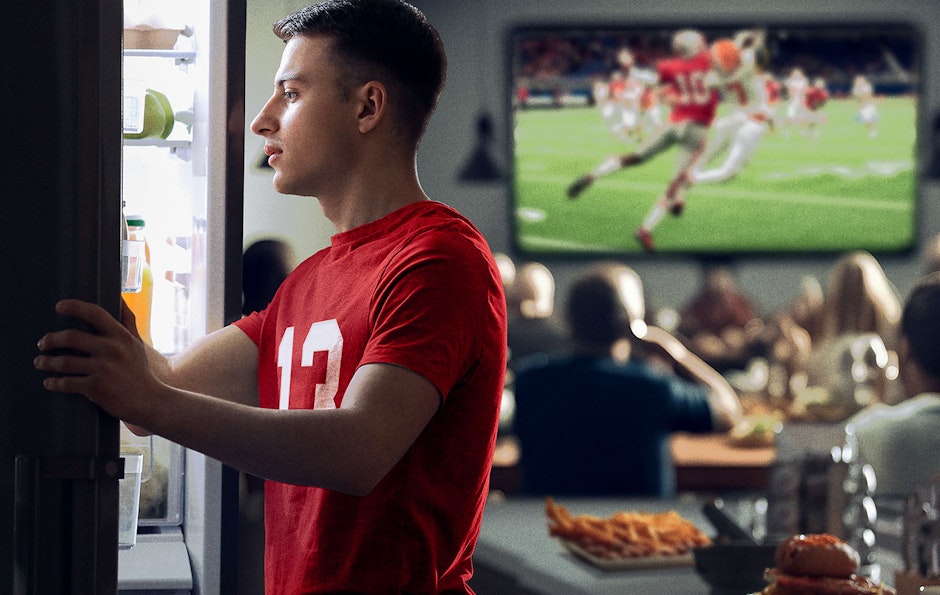Why there’s no Big Game without big sound (and music)
Here, Justine Ryan (VP marketing, Songtradr) analyzes what combo of music and emotion made 2023's Superbowl ads sing.

Okay so here’s the thing: The Super Bowl is all kinds of social, right? Meaning snacking, talking, drinking. And lots of it. Yes, we all love the commercials. But with all these other activities taking place, ad spots need to work even when we’re distracted and can’t see them. Which is to say that the audio has to do double-time, as our attention during commercial breaks is split between chips and dip, chatter about misses and touchdowns, runs to the cooler and quick trips to the bathroom.
The math tells us that people aren’t always seeing your commercial - sometimes they’re just hearing it. Which means that whatever voice or track you use better have some awesome recall power. Otherwise, the ROI on your $7m ad spend during the biggest stateside sporting event of the year won’t be all that you’d hoped for. In fact, the right music choice can boost a brand’s marketing performance by as much as 30%.
Just another reason why music is crucial to a big game spot.
To prove our point, we looked at last year’s Big Game beer spots and found that during Super Bowl LVII, three beer brands ran solo-branded commercials in which music played a prominent role: Budweiser, Busch Light and Michelob Ultra (all three have confirmed ads in 2024). We analyzed each commercial in depth, using advanced AI to profile each piece of music on approximately 300 variables across 28 categories, identifying elements such as mood, genre, personality, target audience, music quality, and source (like custom, stock, commercial). Harvesting this data was critical to calculating variables such as category differentiation, consistency, and audience/brand fit—all of which can influence how effective an ad is at reaching its target audience.
We also used quantitative research with real beer drinkers who watched the game. This allowed us to determine the extent to which the ads were sonically consistent with each brand’s overarching use of music throughout 2022, and whether the music used in its Super Bowl ad enhanced its emotional appeal enough to boost business performance.
Curious what we learned?
Of the three brands measured, Michelob Ultra was the clear winner, enjoying a 6.6% boost in emotion-weighted brand preference amongst the Super Bowl beer-drinking audience. Its spot, starring Serena Williams and actor Brian Cox, featured both licensed and bespoke music. Combined, the two selections helped to cement the “Caddyshack” movie reference central to the ad and supported the modern narrative twist on which the ad was built. The strong result showed that the music clearly resonated with Michelob Ultra’s target audience, enough to spark positive feelings and enhance brand appeal.
Budweiser came in second, with a 1% boost in emotion-weighted brand preference. Several creative decisions likely impacted this result. On the visual side, Budweiser chose not to feature Clydesdales or puppies in its ad, as it had throughout many of its previous commercials (for this year’s spot, the Clydesdales are back). Its choice of audio also took a turn. The brand opted to use just a small portion of its iconic ‘Here Comes the King’ march at the start of the commercial before shifting to a trap-infused hip-hop track from producer Metro Boomin. Since so many people recognize the original march, Budweiser may have had more success combining the two throughout, introducing a more cohesive, unique, and branded sound to the ad that audience members could relate to.
Interestingly enough, further analysis found that the track generally scored 20% higher for monotony than Budweiser’s other music choices to date. As a whole, the music choice didn’t negatively impact Budweiser, but it didn’t boost it significantly either.
Busch Light came in third. Now historically, Busch has made solid strategic music choices in its advertising, preferring to use music that is true to its relatively older demographic. This gives the brand a clear distinctiveness within the category by over-indexing on energetic rock and country sounds and under-indexing on pop, electronic, and hip-hop.
But in 2023, Busch used music sparingly, with only a short clip of Sarah McLaughlin’s 1999 hit “Angel” sandwiched between a few sound effects. The low-energy pop track was a significant musical departure from the brand’s distinctive rock & country sound, and it clearly confused viewers. The numbers showed that Busch Light’s emotional appeal among beer-drinking Super Bowl watchers dropped by 2.9% following the Super Bowl, leading to a 2.1% drop in brand preference.
So what does it all mean?
Music combined with emotion and recall power: that’s the formula for a solid spend, no matter the dollar figure.

